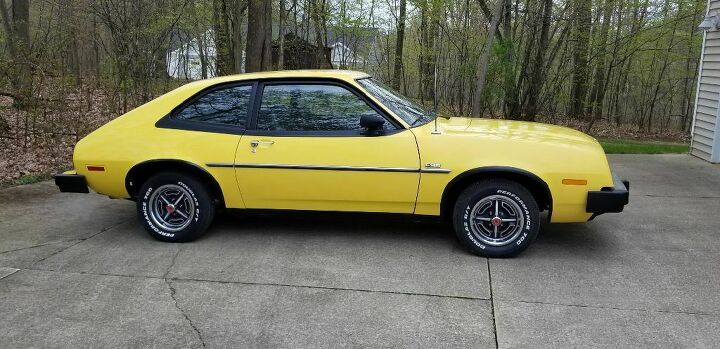Rare Rides: The 1979 Ford Pinto European Sports Sedan Is None of Those Things

In an interesting case of historical marketing, this very yellow Rare Ride seems to have adjectives applied to it which are, in fact, false. Today we have a look at a 1979 Ford Pinto European Sports Sedan.
The late Sixties was a tough time for American OEMs. An onslaught of small, economical, and affordable Japanese cars put a lot of pressure on domestic manufacturers to compete. By the latter part of the decade, boardrooms at the Big Three (and AMC) hummed with compact car ideas.
Ford began development of the Pinto in 1967, under the overall direction of then president Lee Iacocca. Lee wanted a lightweight entry into the market (under 2,000 pounds) that cost less than $2,000. Engineers at Ford jumped to the task, creating a new platform that also served double duty under everyone’s favorite Mustang, the II. From start to finish, Pinto’s development took 25 months — an impressive timeline in an era when new car development typically took 43 months.
Ford introduced the Pinto in September of 1970 for the 1971 model year. New competitors to the Pinto included the Chevrolet Vega and AMC Gremlin from America, plus the Mazda 1200 (later GLC) from Japan.
As was typical of economy cars in the Seventies, multiple body styles greeted Pinto customers. There were two-door sedan, sedan delivery, and station wagon styles, as well as a three-door hatchback. Engines ranged from 1.6 and 2.8 liters in displacement, with the range topped by the Cologne V6.
The Pinto was a very successful car for Ford, but things took a turn in the middle of the decade. Some Pintos caught fire here and there, which led to an NHTSA investigation in 1974 and the eventual publication (in 1977) of Ford’s Pinto Memo. Some 117 lawsuits impacted Ford by the time everyone was said and done. It’s a long, complex story which can’t be covered here.
Ford applied a styling update to the Pinto for 1979, signalling that the company’s smallest offering was not long for this world. Front and rear exterior revisions made it look more like a Fairmont, while the interior underwent its own modernization. The refresh brought with it the ESS package. Available on sedan and hatchback Pintos, ESS added a black grille and trim, wider moldings, sports wheels, and classy ESS badging. The package was around for just two model years, as ESS died with the Pinto in 1980.
Americans prepared themselves to revel in an all-new Escort for 1981.
Today’s Rare Ride was for sale on eBay recently, in shockingly clean condition for a lifelong Michigan vehicle. With a 2.3-liter inline-four and 23,000 miles, this ESS asked $7,995.
[Images: seller]

Interested in lots of cars and their various historical contexts. Started writing articles for TTAC in late 2016, when my first posts were QOTDs. From there I started a few new series like Rare Rides, Buy/Drive/Burn, Abandoned History, and most recently Rare Rides Icons. Operating from a home base in Cincinnati, Ohio, a relative auto journalist dead zone. Many of my articles are prompted by something I'll see on social media that sparks my interest and causes me to research. Finding articles and information from the early days of the internet and beyond that covers the little details lost to time: trim packages, color and wheel choices, interior fabrics. Beyond those, I'm fascinated by automotive industry experiments, both failures and successes. Lately I've taken an interest in AI, and generating "what if" type images for car models long dead. Reincarnating a modern Toyota Paseo, Lincoln Mark IX, or Isuzu Trooper through a text prompt is fun. Fun to post them on Twitter too, and watch people overreact. To that end, the social media I use most is Twitter, @CoreyLewis86. I also contribute pieces for Forbes Wheels and Forbes Home.
More by Corey Lewis
Latest Car Reviews
Read moreLatest Product Reviews
Read moreRecent Comments
- Shipwright Great news for those down south. But will it remove internal heat to the outside / reduce solar heat during cold winter months making it harder to keep the interior warm.
- Analoggrotto Hyundai is the greatest automotive innovator of the modern era, you can take my word for it.
- MrIcky My maintenance costs are pretty high because I enjoy doing questionable things (when it is safe to do so of course). Tires and frequent oil changes seem a small price to pay.
- MaintenanceCosts Dammit, my Highlander's two years too old.
- Analoggrotto so what







































Comments
Join the conversation
Shockingly! Internet writers sure do love that word.
A Mazda based Escort starting in 1991 was a much better car than the 81 thru 89 Escort. How do I know I had an 85 Mercury Lynx (Escort) and a 1994 Escort wagon. Maybe the Focus was a better car but that 1994 was trouble free and the 85 Lynx was not. I was not talking about the Ford Courier I was talking about the mid to late 90's Ranger going thru 2011 which was shared by the Mazda which were better than the earlier Rangers. Mazda brought a lot to Ford's compact and subcompact cars. John Taurus I realized you are foremost a Ford fan but I go by my ownership experience. My 1994 Escort wagon and 2001 Taurus were excellent cars but the 1985 Lynx was nothing but trouble. I am more interested in how a vehicle holds up and how reliable it is and less interested in brand. Maybe I am in the minority in judging vehicles on their reliability and not brand but having owned various vehicles new and used over 44 years I do have some knowledge from experience. Wouldn't mind seeing Mazda making cars for Ford again if Ford latter decides to get back into cars.